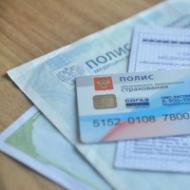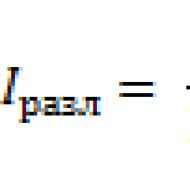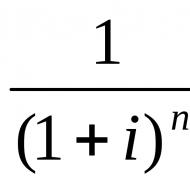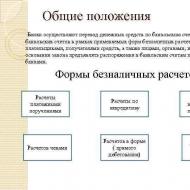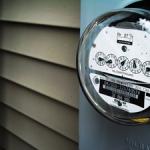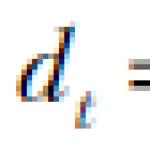
Automated VAT control system 2. ASK VAT: operating principle of the Federal Tax Service service to search for illegal VAT deductions. The sectoral approach is being strengthened
Taxpayers hand over electronic declarations according to VAT, containing indicators of the purchase book and sales book.
In 2015, the Federal Tax Service launched the ASK VAT-2 PC to control declarations.
Reference Abbreviation PC ASK NDS-2 2013
stands for “software package for automated control over value added tax, second version.” At the end
In 2009, the Federal Tax Service launched the ASK VAT-1 PC for the first time.
From this moment on, the Federal Tax Service takes control of data on transactions subject to VAT. 2015
A year later, the Federal Tax Service reported a double reduction in illegal attempts to refund taxes, which added 102 billion rubles to the budget. At first
In 2009, the Federal Tax Service launched the second version of the ASK VAT-2 program. The work of PC ASK VAT-2 is aimed at identifying organizations that do not pay VAT and do not reflect the corresponding tax accruals in.
tax return All information is accumulated in the system Big data
, which is used to process data from PC ASK NDS-2.
Thus, all VAT reports (and therefore all invoices) now fall into the all-Russian database (data center of the Federal Tax Service of Russia in Dubna).
The program is aimed at comparing data on each operation along the goods movement chain. Big Data (Big Data) - a system for processing huge amounts of data, formed in the late 2000s, alternative traditional system
database management (DBMS).
- Defining Characteristics of Big Data:
- data volume,
- data processing speed, variety of simultaneous processing.
Since 2013, big data as an academic subject has been studied in emerging university programs in data science, computational science and engineering.
- Algorithm of operation of ASK VAT-2
- The program compares the VAT charged by the seller (according to his sales book) and the VAT accepted for deduction by the buyer (according to his purchase book).
If these data do not match, the program finds out what is wrong: - whether the seller reflected the sale and how lawfully the buyer claimed tax deductions.
Everything happens without the participation of the inspector: - The tax office automatically sends requests for clarification to the buyer and seller.
- You have five days to respond, and then the local inspectorate begins an inspection.
As a result, taxpayers either correct payment errors themselves or receive notification of additional assessments.

Scheme of operation of ASK NDS-2By introducing PC ASK VAT-2, tax authorities actually automated the classic “counter check”, for greater efficiency, also making the necessary amendments to tax code, which started working at the beginning of 2015. The use of new Big Data technologies allows you to automatically compare counterparty data, quickly identify and suppress the illegal activities of fraudulent companies that do not fulfill their obligations. tax obligations. Now the Federal Tax Service, having identified inconsistencies in the reporting of the buyer and seller, can request invoices and primary documentation. And from the company that did not confirm receipt tax requirements or notifications, tax authorities may block accounts.
How tax authorities and ASK VAT-2 work
- You submit a VAT return.
- The system independently analyzes data for each operation along the chain of movement of goods and identifies tax gaps in transactions for which there is a deduction, but VAT has not been paid.
- Unscrupulous VAT payers are automatically detected, and a tree of connections with other participants in the trade turnover is built.
- The totality of the data obtained allows tax authorities to identify the beneficiary of VAT tax deductions.
It can become absolutely any organization or individual entrepreneur claiming to tax deduction- after all, the right to deductions is obtained by those who buy goods (works or services) from their counterparties who present the amount of tax (clause 2 of Article 171 of the Tax Code of the Russian Federation). - Or passed zero declaration according to VAT.
- Or he didn’t pass it at all.
- Or you submitted the declaration, but did not reflect the invoice issued to you in the sales book (or distorted the data).
- If contradictions are identified in the VAT declaration, the system automatically generates a request for explanations.
- This is followed by other tax control measures. Let's say a tax gap is identified.
To identify the recipient of an unjustified tax benefit, inspectors can use an expanded list of tax control measures already within the chamber: requesting a voluminous list of documents, inspecting premises, territories, interviewing employees, etc. ... - Conscientious taxpayers are also under attack.
Most audits after identifying tax gaps end unfavorably.
Claims by inspectors for violations of third parties can be made specifically against bona fide companies and, more likely, against those who have property. Even in cases where you yourself interact with a bona fide counterparty, but there are “gray” or “black” companies in the chain. - The number of tax audits initiated thanks to the VAT-2 ASK is growing and, as judicial practice shows, most of these audits resulted in a victory for the tax authorities in the form of additional assessments or denials of deductions.
- Tax authorities continue to improve tax administration VAT.
A new software package is coming ASK VAT-3.
What does "tax gap" mean?
This is when your counterparty:Thus, often all headache from ASK VAT-2 is caused by erroneous action/inaction of our counterparties or the presence of relationships between them and shell companies.
In 2015, the Federal Tax Service launched the ASK VAT-2 PC to control declarations.
Reference Abbreviation stands for “software package for automated control over value added tax, second version.” At the end 2013
In 2009, the Federal Tax Service launched the ASK VAT-1 PC for the first time.
From this moment on, the Federal Tax Service takes control of data on transactions subject to VAT.
A year later, the Federal Tax Service reported a double reduction in illegal attempts to refund taxes, which added 102 billion to the budget. rubles At first 2015
In 2012, the Federal Tax Service launched the second version of the ASK VAT-2 program. The work of the ASK VAT-2 program is aimed at identifying organizations that do not pay VAT and do not reflect the corresponding tax charges in the tax return.
All information is accumulated in the system All information is accumulated in the system, which is used to process data from PC ASK NDS-2.
Thus, all VAT reports (and therefore all invoices) now fall into the all-Russian database (data center of the Federal Tax Service of Russia in Dubna).
The program is aimed at comparing data on each operation along the goods movement chain.
The program is aimed at comparing data on each operation along the goods movement chain.(Big Data) is a system for processing huge volumes of data, formed in the late 2000s, an alternative to the traditional database management system (DBMS).
Defining Characteristics of Big Data:
- Defining Characteristics of Big Data:
- data volume,
- data processing speed, variety of simultaneous processing.
Since 2013, big data as an academic subject has been studied in emerging university programs in data science, computational science and engineering.
Algorithm of operation of ASK VAT-2
- Algorithm of operation of ASK VAT-2
- The program compares the VAT charged by the seller (according to his sales book) and the VAT accepted for deduction by the buyer (according to his purchase book).
If these data do not match, the program finds out what is wrong: - whether the seller reflected the sale and how lawfully the buyer claimed tax deductions.
Everything happens without the participation of the inspector: - The tax office automatically sends requests for clarification to the buyer and seller.
- You have five days to respond, and then the local inspectorate begins an inspection.
Scheme of operation of ASK NDS-2
 Scheme of operation of ASK NDS-2
By introducing the PC ASK VAT-2, tax officials actually automated the classic “counter check”, for greater efficiency, also making the necessary amendments to the Tax Code, which began to work from the beginning of 2015. The use of new Big Data technologies makes it possible to automatically compare the data of counterparties, quickly identify and suppress the illegal activities of fraudulent companies that do not fulfill their tax obligations. Now the Federal Tax Service, having identified inconsistencies in the reporting of the buyer and seller, can request invoices and primary documentation from companies. And a company that has not confirmed receipt of tax demands or notifications may have its accounts blocked by tax authorities.
Scheme of operation of ASK NDS-2
By introducing the PC ASK VAT-2, tax officials actually automated the classic “counter check”, for greater efficiency, also making the necessary amendments to the Tax Code, which began to work from the beginning of 2015. The use of new Big Data technologies makes it possible to automatically compare the data of counterparties, quickly identify and suppress the illegal activities of fraudulent companies that do not fulfill their tax obligations. Now the Federal Tax Service, having identified inconsistencies in the reporting of the buyer and seller, can request invoices and primary documentation from companies. And a company that has not confirmed receipt of tax demands or notifications may have its accounts blocked by tax authorities.
How tax authorities and ASK VAT-2 work
- You submit a VAT return.
- The system independently analyzes data for each operation along the chain of movement of goods and identifies tax gaps in transactions for which there is a deduction, but VAT has not been paid.
- Unscrupulous VAT payers are automatically detected, and a tree of connections with other participants in the trade turnover is built.
- The totality of the data obtained allows tax authorities to identify the beneficiary of VAT tax deductions.
It can be absolutely any organization or individual entrepreneur claiming a tax deduction - after all, the right to deductions is given to those who buy goods (works or services) from their counterparties who present the tax amount (clause 2 of Art.
ASK VAT-2: new service from the Federal Tax Service for checking VAT returns
171 of the Tax Code of the Russian Federation). What does "tax gap" mean?
This is when your counterparty:
- Or submitted a zero VAT return.
- Or he didn’t pass it at all.
- Or you submitted the declaration, but did not reflect the invoice issued to you in the sales book (or distorted the data).
Thus, often all the headaches from ASK VAT-2 are caused by erroneous actions/inactions of our counterparties or the existence of relationships they have with shell companies.
To identify the recipient of an unjustified tax benefit, inspectors can use an expanded list of tax control measures already within the chamber: requesting a voluminous list of documents, inspecting premises, territories, interviewing employees, etc. ...
Most audits after identifying tax gaps end unfavorably.
Claims by inspectors for violations of third parties can be made specifically against bona fide companies and, more likely, against those who have property. Even in cases where you yourself interact with a bona fide counterparty, but there are “gray” or “black” companies in the chain.
A new software package is coming ASKNDS-3.
Taxpayers hand over electronic VAT returns, containing indicators of the purchase book and sales book. In 2015, the Federal Tax Service launched the ASK VAT-2 PC to control declarations.
ASK VAT-2: where should taxpayers expect threats?
Starting from the first quarter of 2015, taxpayers submit VAT returns according to new form (Order of the Ministry of Finance of Russia dated October 29, 2014 No. ММВ-7-3/558@). Now the company reports to the tax authorities information from the purchase book and sales book and information about issued invoices (sections 8–12 of the declaration).
The tax authorities have at their disposal a special automated system control of VAT-2 (hereinafter - ASK VAT-2). This system stores and accumulates all information on taxpayer transactions. Let's consider what claims tax authorities make based on the results of the analysis of the ASK VAT-2 database.
The system identifies discrepancies in declarations
ASK VAT-2 allows tax authorities to compare information from purchase books and sales books along the chain from the supplier to the final buyer. The program verifies counterparties, invoices and tax amounts indicated on them. The system can detect several types of discrepancies.
Discrepancies of the type “VAT”. The program identifies these discrepancies when the tax is indicated in the declarations, but there are errors in them. The list of such errors is known to many accountants. These are discrepancies in the transaction code, incorrect invoice number or date, as well as discrepancies in the amount of VAT payable by the seller and deductible by the buyer.
Some accountants agree with the requirements of inspectors and submit updated declarations. However, if there is technical errors that do not affect the amount of tax, it is enough to provide explanations. They must be accompanied by invoices and other documents. In this case, providing clarification is the right and not the obligation of the taxpayer ( para. 2 p. 1 art. 81 Tax Code of the Russian Federation). This includes typos in invoice numbers and dates and incorrect transaction codes. If the company does not match the amount of VAT declared for deduction on the invoice from the supplier, then the most common case is the presentation of VAT for deduction in a later period. For example, the supplier posted an invoice in the first quarter of 2016, and the buyer accepted VAT for deduction in the second quarter of 2016.
Discrepancies of the “gap” type. We are talking about the so-called tax gap. When comparing data from the purchase and sales books, it turns out that the counterparty whose invoice is stated in the declaration is simply not in the Unified State Register of Legal Entities. Or doesn't pass tax reporting, or passes it with zero marks. With this type of gap, the taxpayer receives an invoice, the amount of tax for which is not reflected in the counterparty’s declaration. If the company is a supplier and VAT is declared for payment, then, most likely, this will not cause suspicion, since VAT has been paid to the budget. But if the company is a buyer and has declared this VAT deductible, then the inspectorate will most likely immediately formulate a requirement to submit documents ( clause 8.1 art. 88 Tax Code of the Russian Federation).
However, if the company has submitted the entire package of documents, then it is not yet possible to refuse deductions based on discrepancies identified according to the AKS VAT-2 data. The sign of a deduction is the presence of an invoice ( Art. 169 Tax Code of the Russian Federation). And if the inspectors intend to refuse deductions, then they are obliged to carry out tax control measures. These measures must prove the fictitiousness of one-day transactions or the presence of other unjustified tax benefits.
IN judicial practice There are interesting cases of losses for tax authorities when they denied companies deductions on invoices of counterparties that were not included in the Unified State Register of Legal Entities. In one of the cases, the accountant of a company excluded from the Unified State Register of Legal Entities continued to issue invoices on behalf of a non-existent company for two years ( decision of the Moscow City Court of June 20, 2013 No. A40-18764/13).
The tax authority denied deductions. The company redid the invoices and submitted them to the court. The arbitrators indicated that the organization did not suspect that the invoices were invalid and could not verify this fact. The court canceled the additional assessments. At the same time, the company could check the status of the counterparty using publicly available services on the website of the Federal Tax Service of Russia. Therefore, such court decisions are rather isolated and cannot be relied upon.
Taxpayers are faced with a tax gap when ASK VAT-2 cannot compare invoices for advances issued and when offsetting these advances. This is due to the fact that the company that paid the counterparty an advance prepares the invoice itself. Even if you have the correct transaction code, ASK VAT-2 often generates a requirement indicating the absence of a “twin” invoice. IN in this case It is enough to provide written explanations and attach documents to them.
The purpose of introducing ASK VAT-2 is to combat fly-by-night scams
ASK VAT-2 helps tax authorities identify an unscrupulous link in the trade chain - a fly-by-night. The stage at which the tax has not reached the budget. This is necessary to find the ultimate beneficiary who receives unjustified benefits from tax gaps. The risk management system “SUR ASK NDS-2” is responsible for searching for beneficiaries. Its main tasks are described in the letter of the Federal Tax Service of Russia dated 06/03/16 No. ED-4-15/9933@“On the assessment of RMS risk signs.” Taxpayers may fall into low, medium and high risk groups. Companies with low tax risk have material and labor resources, conduct real activities, pay taxes. They have on-site inspections.
Organizations with persistent signs of ephemeral activity are classified as high-risk. They have no assets or personnel, pay little taxes with high turnover, and use third parties to make payments. Inspectors mark the company's risk group in the program using color indicators. Tax authorities use the results of “SUR ASK VAT-2” when deciding on VAT refunds and planning on-site audits.
For effective use ASK NDS-2 inspectors received expanded powers in the camera rooms. They use almost the same list of control measures as during on-site inspections. Inspectors may require the company to provide:
- documents due to discrepancies in transactions ( clause 8.1 art. 88, Art. 93 Tax Code of the Russian Federation, Appendix No. 15 To );
- explanations ( clause 3 art. 88 Tax Code of the Russian Federation, application no. 1 To Order of the Federal Tax Service of Russia dated 05/08/15 No. ММВ-7-2/189@).
If the organization has received a request, it is necessary to send a receipt of receipt of the electronic document via telecommunications channels within six working days. Otherwise, the inspectorate may block bank accounts ( subp. 1.1 clause 3 art. 76 Tax Code of the Russian Federation).
Taxpayers send a response to the request for the submission of documents to the inspectorate within 10 working days from the date of receipt of the request ( clause 8.1 art. 88, Art. 93 Tax Code of the Russian Federation). And written explanations - within five working days ( clause 3 art. 88 Tax Code of the Russian Federation).
Companies rarely ignore document submission requirements. This is fraught with a fine ( Art. 126 Tax Code of the Russian Federation) and denial of deductions on formal grounds.
It is better to provide explanations too. Otherwise, the inspector will draw up a desk inspection report ( clause 5 art. 88 Tax Code of the Russian Federation). Then you will have to recoup additional charges by filing objections or in court.
However, confirming the right to deduct during a camera meeting does not guarantee that the company will not schedule an on-site inspection ( Art. 89 Tax Code of the Russian Federation).
ASK VAT 2: judicial practice
The duration of a desk inspection is limited to three months, so inspectors often do not have time to collect evidence that can stand up in court. The courts believe that inspectors have the right to order an on-site inspection of a period that has already been inspected off-site. Taxpayers are not exempt from liability for detected offenses ( Resolution of the Federal Antimonopoly Service of the West Siberian District dated June 24, 2011 No. A75-8783/2010).
Tax officials can also schedule an on-site audit after tax control activities, which will be carried out by the pre-audit analysis department. Maximum term on-site inspection reaches 15 months. Subject to extension (up to six months) and suspension (six or nine months). During such an impressive period of time, inspectors will definitely collect the necessary evidence.
Judicial practice on ASK VAT-2 has not yet been formed
The argument about “tax gaps” in the ASK VAT-2 database is new for judicial practice. So far it is rare. There are several reasons for this.
Firstly, ASK VAT-2 is an internal database of the tax authorities; there is no public access to it. Courts do not recognize information from internal information resources as proper evidence ( Resolution of the Moscow District AS of December 28, 2015 No. F05-18124/2015). The company may learn about the fiscal conclusions made on the basis of internal information no earlier than negative tax consequences occur.
Second, the tax gap itself does not prove that the tax benefit is unreasonable. This gap is only a mathematical result control ratios numbers in two declarations. If the numbers are different, this is just a reason to check.
Nevertheless, information from the ASK VAT-2 has already begun to appear in judicial practice. And not only in disputes related to VAT deductions.
For example, in Resolution of the Volga Region Autonomous District dated June 24, 2016 No. Ф06-9933/2016 the company challenged the refusal of the tax authority to register the liquidation of a legal entity in the Unified State Register of Legal Entities*. The company compiled a liquidation balance sheet and submitted it to the inspectorate. However, the inspection, based on the results of two chamber VAT declarations, denied the company deductions for an impressive amount and handed over inspection reports.
* Read more about this in the article “Tax officials refused to liquidate a company with an unreliable balance sheet” on the website e.nalogplan.ru or in “PNP” No. 9, 2016, p. 82.
After the decisions on cameras come into force tax authority could post the VAT debt on a personal account and become a creditor of the company. In addition, at the time of filing the liquidation application, the company had not submitted another VAT return.
As a result, the inspectorate recognized the company's balance sheet as unreliable and refused state registration of the changes. In the decision of the appellate instance, the judges indicated that the tax authority, with the help of the VAT-2 ASK, established the existence of a tax gap in the form of an illegally declared VAT deduction ( Resolution of the Twelfth AAS dated April 15, 2016 No. 12AP-2681/2016).
The tax authorities issued demands for the presentation of documents. The company ignored the demands and did not provide documents. The head of the company also avoided appearing for questioning.
The company believed that at the time of filing the liquidation balance sheet, the tax authority did not have a decision on desk audits. Therefore, the amount of VAT payable was unknown to him. However, the court took into account the fact of opposition and evasion of society from submitting documents. And I came to the conclusion that the application for liquidation was filed to avoid additional charges due to inspections.
The court decided that the company knowingly provided false information, and the liquidation procedure cannot be considered complied with. The legality of additional accruals based on desk audits was not the subject of the dispute. Therefore, regarding the unreliability of the balance sheet, the court supported the inspection.
The unusual case was considered by the Nineteenth AAS ( Resolution dated August 31, 2016 No. A14-16854/2015). The evidence found in the ASC VAT-2 was stated by one of the parties in a civil dispute. It was between two legal entities regarding the falsification of the manager’s signature in an agreement.
The company went to court with a demand to collect from the counterparty the debt under the supply agreement for 12 tons of fishmeal. However, the buyer unexpectedly declared in court that the manager’s signature on the contract was fake. This means that the deal was not concluded and there are no grounds for compensating the seller for losses.
As evidence of the reality of the shipment, the supplier presented a contract, an invoice for acceptance of goods, emails to the buyer and responses to them. In addition, the seller submitted a letter from the inspection stating that, based on the results desk audits declarations of both companies, the tax authority found an invoice for the supply of fishmeal in both the seller’s and the buyer’s declarations. The tax authorities found the invoice by cross-comparing declarations in the ASK VAT-2 system.
The tax authorities confirmed that the buyer claimed a deduction due to the fact that the seller reflected the transaction in the declaration and paid VAT on it to the budget. The court concluded that the buyer concealed information about the delivery from the court and did not allege falsification of evidence. In connection with this, the court decided to recover the entire amount of debt and a penalty from the negligent buyer.
ASK NDS-2
ASK VAT-2 has been operating for three years. It stores information from invoices, VAT returns, and transaction information. The system collects data on VAT payment throughout the entire trade chain: from the primary supplier to the final consumer.
The operation of the system is ensured by data processing centers (DPCs) in Nizhny Novgorod and Moscow region. In 2017–2020, the authorities plan to build a backup data center in the Volgograd region.
Data centers allow the Federal Tax Service of Russia to implement other administration tools. This is tax monitoring, a system for monitoring the application cash register equipment(ASK KKT), electronic services. They also support the work. information systems Ministry of Finance, Federal Tax Service, Treasury and other financial department institutions.
ASK VAT 3: a new “tracking complex” for business
ASK VAT-2: how VAT returns are checked
Automated control system VAT-2 (ASK VAT-2) — software, developed and used by the Federal Tax Service (FTS) of Russia to receive, record and process VAT return data from taxpayers.
Explanation
The automated VAT-2 control system (ASK VAT-2) was developed by the Federal Tax Service of Russia and is used to receive, record and process VAT tax return data from taxpayers.
Since January 1, 2015, this system analyzes data on taxpayer invoices declared in tax returns and identifies contradictions between taxpayer invoices. So, if, for example, it turns out that the buyer has deducted VAT, but the seller does not charge it, then this fact may become a reason for a tax audit.
ASK VAT - a new service of the Federal Tax Service for searching for illegal VAT deductions
in Art. 88 "Cameral tax audit" (federal law dated June 28, 2013 N 134-FZ), which gives the tax authorities the right in such situations to request from the taxpayer invoices, primary and other documents related to these transactions:
Clause 8.1. Art. 88 of the Tax Code of the Russian Federation: “If contradictions are identified between information about transactions contained in the tax return for value added tax, or when information about transactions contained in the tax return for value added tax submitted by the taxpayer is identified, information about specified operations, contained in the tax return for value added tax submitted to the tax authority by another taxpayer (another person who, in accordance with Chapter 21 of this Code, is entrusted with the obligation to submit a tax return for value added tax), or in the log of received and issued invoices submitted to the tax authority by a person who, in accordance with Chapter 21 of this Code, is entrusted with the corresponding responsibility, if such contradictions and inconsistencies indicate an understatement of the amount of value added tax payable to the budget, or an overstatement of the amount of tax for the added value claimed for reimbursement, the tax authority also has the right to request from the taxpayer invoices, primary and other documents related to these transactions.”
The development and implementation of the VAT-2 system was determined by the documents:
Order of the Federal Tax Service of Russia dated July 15, 2013 N ММВ-7-3/239@ "On conducting a pilot software project that implements the functions of the task "Automated system for monitoring VAT refunds"
Order of the Federal Tax Service of Russia dated October 1, 2013 N ММВ-7-6/432@ "On the introduction into commercial operation of software that implements the functions of the task "Automated system for monitoring VAT refunds"
ASK VAT-3
The Federal Tax Service of Russia does not stop at improving the VAT control mechanism. Developed and tested a new version VAT verification programs - ASK VAT-3. This version of the program has added integration with banks and allows tax authorities to identify situations, for example, when a buyer received an invoice and claimed a deduction, but the buyer cash does not list for a long time. This situation may indicate illegal optimization of VAT.
Additionally
The risk management system "SUR ASK NDS-2" is software that automatically distributes taxpayers - legal entities who submitted value added tax returns, based on the information available to the tax authority about the activities of taxpayers, into 3 tax risk groups: high, medium, low.
AIS Tax-3 is an automated information system of the Federal tax service Russian Federation.
The “Link Tree” report is a report that is generated in the Risk Management System “SUR ASK NDS-2” and is used by tax authorities to identify illegal transactions.
ASK NDS-2 (gnivc.ru)
Federal Tax Service and taxes - the popularity of these abbreviations and words has peaked in recent weeks. Campaign against shell companies electronic formats invoices, growth in tax collections... The Federal Tax Service reports on the successful completion of 2015 and the beginning of 2015. What does the tax service attribute its success to? With the introduction of the ASK NDS-2 software package.
What is ASK VAT-2?
This is the second version of the automated VAT payment control system. The first version was implemented in 2013, and the revised version was implemented in January 2015.
To put it very simply: information from the taxpayer’s reporting is automatically compared with the data of its suppliers and customers. If there is a discrepancy in the chain, the program signals this to the company. The company must explain the reason within 5 days. If there are no explanations, the tax inspector gets down to business. Having checked the reasons for the discrepancies, he decides whether to reimburse the company for VAT or refuse it.
Previously, checking the chain of counterparties took a lot of time. Now the minutes are counting.
The Federal Tax Service noted that the results of using ASK VAT-2 are already impressive. The program identified an “error” in the data of every tenth company in Russia. 20-30% of taxpayers who were approached by the tax authorities with questions refuse the claimed refund from the VAT budget and submit “clarifications”.
Is this program effective?
The effectiveness of the program is obvious in terms of quickly identifying errors in counterparty chains. The automated system helps to cover 100% of counterparties. Previously, tax inspectors did not have enough time for this.
Whether the implementation of the program resulted in a positive trend in tax revenue growth is another question. The increase could (and most likely) was influenced by a combination of factors: taxpayers declaring VAT in large amounts, judicial practice in 2014-2015 in favor of tax authorities, strengthening the quality and effectiveness of tax control not related to ASK.
How to avoid being blacklisted?
Be confident in your counterparties. How to check the integrity of those with whom you work? In addition to requesting documents on the legal capacity of a legal entity and the competence of persons to sign documents, we recommend:
- Check financial statements counterparty for the presence of fixed assets and intangible assets.
- Go to the counterparty’s website, look for reviews about the company on the Internet.
- Check whether the counterparty has an office (warehouse): not on paper, but in reality.
- Check judicial history counterparty.
The Federal Tax Service is not going to stop at the ASK VAT-2 version. The plans include synchronizing the work of the program with the databases of the customs service, the Central Bank of the Russian Federation and Rosfinmonitoring.
Recently, the Federal Tax Service has been whitewashing entire industries through special charters for market participants. This mechanism has already been tested on grain exporters, the fishing industry, electronics engineers, retail networks, pharmacists. The main goal of the tax service is clear: to destroy the shadow market as a phenomenon. And for this, the Federal Tax Service of Russia today has everything necessary tools. Everyone knows about the existence of the ASK VAT-2 and ASK VAT-3 software packages, but they do not fully understand the mechanism of operation.
What does ASK VAT-3 give to tax authorities?
ASK VAT-3 allows tax specialists to fully automate the process of monitoring the movement of funds between the accounts of legal entities and individuals and increase its productivity from 10 to 100%.The intelligent search algorithm makes it possible to automatically build chains of money movement between legal entities and individuals and see, among other things, whether VAT has been paid in these chains.
In practice, this means that finding interdependent companies and related individuals it will become much easier. Having detected a break in the chain, the program sends a signal, which must be further checked by tax officials.Tax authorities now have a new division on their staff, numbering about 6 thousand analysts.
Why is ASK VAT-3 dangerous?
In 2018, the complex will be implemented in all regions of the country and will receive qualitatively new capabilities.ATTENTION! The ASK NDS-3 software package automatically generates a report, which since November 2017 is a sufficient basis for initiating a criminal case if the amount of violations exceeds statutory size.That is, if previously, in order to initiate a criminal case, the Investigative Committee of Russia had to conduct a pre-investigation check, request counter documents from the counterparty, compare data and draw conclusions, now this is not required, the inspector of the Federal Tax Service only needs to press one button.
If a software-analytical complex decides that a company has evaded paying taxes using any scheme (be it splitting up a company, creating fly-by-night companies or a chain of intermediaries), then a printout in the hands of an inspector today is already sufficient grounds for initiating a criminal case.
What are extraterritorial checks
In addition, tax officials now have a new tool - extraterritorial inspections, thanks to which they can come to an “amicable” agreement with their tax inspector will no longer be possible, since the data provided by the company will be checked by Federal Tax Service employees from another district tax office, and possibly even from another city, which significantly reduces the possibility of extra-legal reduction of tax risks.WITH special attention starting from 2018, the Federal Tax Service plans to monitor tenders. This is supposed to be done with the help of industry associations of market participants.
The sectoral approach is being strengthened
In general, tax authorities have changed their approach to tax collection issues. If previously checks concerned individual large companies, then for some time now work has been carried out across entire industries.“The industry-wide approach to conducting inspections has already proven its effectiveness in the pharmaceutical, jewelry, and alcohol sectors of the economy,” said the head of the Control Department of the Federal Tax Service. Maxim Chalikov at a round table with participants in the professional cleaning market and technical operation.
In 2018, all innovations will be implemented in the cleaning industry. It must be remembered that customers of cleaning services and technical operation of buildings and structures, who previously avoided responsibility, are also at risk.
From now on, for the Federal Tax Service, customers also become “beneficiaries of aggressive tax optimization.” The Federal Tax Service has already compiled a list of about 8,000 companies in the industry that will come under close control in 2018. All current contracts of these companies are being assessed for tax burden, which in cleaning should be more than 30% of turnover.This load is due to the large amount of manual labor included in costs, which ranges from 70 to 95 percent.
All these measures will force the facility industry (professional cleaning and technical operation) to come out of the “shadow” and work freely with full payment of the necessary fiscal payments to the state budget.
The largest cleaning companies have already united into the National Association of Facility Operators NAFO, which has developed an industry Charter and is open to accepting new members. NAFO also carries out extensive explanatory and methodological work aimed at assisting Customers in minimizing possible problems related to the campaign conducted by the Federal Tax Service.
If your company's expenses do not include cleaning and maintenance services — you are lucky. Otherwise, it is necessary to audit existing contracts and negotiate with your counterparty on guarantees of payment of 100% of taxes under the concluded contract. You should also inform the company's security service - checking the service provider for tax integrity is their task.
For conscientious companies using service outsourcing services, the threat is the possible loss of VAT deduction due to illegal actions of counterparties. The tax office may refuse a deduction on the basis that the counterparty has signs of being one-day.
Starting from the first quarter of 2015, taxpayers submit VAT returns using a new form ( Order of the Ministry of Finance of Russia dated October 29, 2014 No. ММВ-7-3/558@). Now the company reports to the tax authorities information from the purchase book and sales book and information about issued invoices (sections 8–12 of the declaration).
The tax authorities have at their disposal a special automated control system for VAT-2 (hereinafter referred to as ASK VAT-2). This system stores and accumulates all information on taxpayer transactions. Let's consider what claims tax authorities make based on the results of the analysis of the ASK VAT-2 database.
The system identifies discrepancies in declarations
ASK VAT-2 allows tax authorities to compare information from purchase books and sales books along the chain from the supplier to the final buyer. The program verifies counterparties, invoices and tax amounts indicated on them. The system can detect several types of discrepancies.
Discrepancies of the type “VAT”. The program identifies these discrepancies when the tax is indicated in the declarations, but there are errors in them. The list of such errors is known to many accountants. These are discrepancies in the transaction code, incorrect invoice number or date, as well as discrepancies in the amount of VAT payable by the seller and deductible by the buyer.
Some accountants agree with the requirements of inspectors and submit updated declarations. However, if there are technical errors that do not affect the amount of tax, it is sufficient to provide an explanation. They must be accompanied by invoices and other documents. In this case, providing clarification is the right and not the obligation of the taxpayer ( para. 2 p. 1 art. 81 Tax Code of the Russian Federation). This includes typos in invoice numbers and dates and incorrect transaction codes. If the company does not match the amount of VAT declared for deduction on the invoice from the supplier, then the most common case is the presentation of VAT for deduction in a later period. For example, the supplier posted an invoice in the first quarter of 2016, and the buyer accepted VAT for deduction in the second quarter of 2016.
Discrepancies of the “gap” type. We are talking about the so-called tax gap. When comparing data from the purchase and sales books, it turns out that the counterparty whose invoice is stated in the declaration is simply not in the Unified State Register of Legal Entities. Either he does not submit tax reports, or he submits them with zero indicators. With this type of gap, the taxpayer receives an invoice, the amount of tax for which is not reflected in the counterparty’s declaration. If the company is a supplier and VAT is declared for payment, then, most likely, this will not cause suspicion, since VAT has been paid to the budget. But if the company is a buyer and has declared this VAT deductible, then the inspectorate will most likely immediately formulate a requirement to submit documents ( clause 8.1 art. 88 Tax Code of the Russian Federation).
However, if the company has submitted the entire package of documents, then it is not yet possible to refuse deductions based on discrepancies identified according to the AKS VAT-2 data. The sign of a deduction is the presence of an invoice ( Art. 169 Tax Code of the Russian Federation). And if the inspectors intend to refuse deductions, then they are obliged to carry out tax control measures. These measures must prove the fictitiousness of one-day transactions or the presence of other unjustified tax benefits.
In judicial practice, there are interesting cases of losses for tax authorities when they refused to allow companies to make deductions on invoices of counterparties that were not included in the Unified State Register of Legal Entities. In one of the cases, the accountant of a company excluded from the Unified State Register of Legal Entities continued to issue invoices on behalf of a non-existent company for two years ( decision of the Moscow City Court of June 20, 2013 No. A40-18764/13).
The tax authority denied deductions. The company redid the invoices and submitted them to the court. The arbitrators indicated that the organization did not suspect that the invoices were invalid and could not verify this fact. The court canceled the additional assessments. At the same time, the company could check the status of the counterparty using publicly available services on the website of the Federal Tax Service of Russia. Therefore, such court decisions are rather isolated and cannot be relied upon.
Taxpayers are faced with a tax gap when ASK VAT-2 cannot compare invoices for advances issued and when offsetting these advances. This is due to the fact that the company that paid the counterparty an advance prepares the invoice itself. Even if you have the correct transaction code, ASK VAT-2 often generates a requirement indicating the absence of a “twin” invoice. In this case, it is enough to provide written explanations and attach documents to them.
The purpose of introducing ASK VAT-2 is to combat fly-by-night scams
ASK VAT-2 helps tax authorities identify an unscrupulous link in the trade chain - a fly-by-night. The stage at which the tax has not reached the budget. This is necessary to find the ultimate beneficiary who receives unjustified benefits from tax gaps. The risk management system “SUR ASK NDS-2” is responsible for searching for beneficiaries. Its main tasks are described in the letter of the Federal Tax Service of Russia dated 06/03/16 No. ED-4-15/9933@“On the assessment of RMS risk signs.” Taxpayers may fall into low, medium and high risk groups. Companies with low tax risk have material and labor resources, conduct real activities, and pay taxes. They have on-site inspections.
Organizations with persistent signs of ephemeral activity are classified as high-risk. They have no assets or personnel, pay little taxes with high turnover, and use third parties to make payments. Inspectors mark the company's risk group in the program using color indicators. Tax authorities use the results of “SUR ASK VAT-2” when deciding on VAT refunds and planning on-site audits.
For the effective use of ASK VAT-2, inspectors received expanded powers at their desks. They use almost the same list of control measures as during on-site inspections. Inspectors may require the company to provide:
- documents due to discrepancies in transactions ( clause 8.1 art. 88, Art. 93 Tax Code of the Russian Federation, Appendix No. 15 To );
- explanations ( clause 3 art. 88 Tax Code of the Russian Federation, application no. 1 To Order of the Federal Tax Service of Russia dated 05/08/15 No. ММВ-7-2/189@).
If the organization has received a request, it is necessary to send a receipt of receipt of the electronic document via telecommunications channels within six working days. Otherwise, the inspectorate may block bank accounts ( subp. 1.1 clause 3 art. 76 Tax Code of the Russian Federation).
Taxpayers send a response to the request for the submission of documents to the inspectorate within 10 working days from the date of receipt of the request ( clause 8.1 art. 88, Art. 93 Tax Code of the Russian Federation). And written explanations - within five working days ( clause 3 art. 88 Tax Code of the Russian Federation).
Companies rarely ignore document submission requirements. This is fraught with a fine ( Art. 126 Tax Code of the Russian Federation) and denial of deductions on formal grounds.
It is better to provide explanations too. Otherwise, the inspector will draw up a desk inspection report ( clause 5 art. 88 Tax Code of the Russian Federation). Then you will have to recoup additional charges by filing objections or in court.
However, confirming the right to deduct during a camera meeting does not guarantee that the company will not schedule an on-site inspection ( Art. 89 Tax Code of the Russian Federation). The duration of a desk inspection is limited to three months, so inspectors often do not have time to collect evidence that can stand up in court. The courts believe that inspectors have the right to order an on-site inspection of a period that has already been inspected off-site. Taxpayers are not exempt from liability for detected offenses ( Resolution of the Federal Antimonopoly Service of the West Siberian District dated June 24, 2011 No. A75-8783/2010).
Tax officials can also schedule an on-site audit after tax control activities, which will be carried out by the pre-audit analysis department. The maximum period for an on-site inspection is 15 months. Subject to extension (up to six months) and suspension (six or nine months). During such an impressive period of time, inspectors will definitely collect the necessary evidence.
Judicial practice on ASK VAT-2 has not yet been formed
The argument about “tax gaps” in the ASK VAT-2 database is new for judicial practice. So far it is rare. There are several reasons for this.
Firstly, ASK VAT-2 is an internal database of the tax authorities; there is no public access to it. Courts do not recognize information from internal information resources as proper evidence ( Resolution of the Moscow District AS of December 28, 2015 No. F05-18124/2015). The company may learn about the fiscal conclusions made on the basis of internal information no earlier than negative tax consequences occur.
Second, the tax gap itself does not prove that the tax benefit is unreasonable. This gap is only a mathematical result of the control ratios of the numbers in the two declarations. If the numbers are different, this is just a reason to check.
Nevertheless, information from the ASK VAT-2 has already begun to appear in judicial practice. And not only in disputes related to VAT deductions.
For example, in Resolution of the Volga Region Autonomous District dated June 24, 2016 No. Ф06-9933/2016 the company challenged the refusal of the tax authority to register the liquidation of a legal entity in the Unified State Register of Legal Entities*. The company compiled a liquidation balance sheet and submitted it to the inspectorate. However, the inspection, based on the results of two chamber VAT declarations, denied the company deductions for an impressive amount and handed over inspection reports.
* Read more about this in the article “Tax officials refused to liquidate a company with an unreliable balance sheet” on the website e.nalogplan.ru or in “PNP” No. 9, 2016, p. 82.
After the cameral decisions come into force, the tax authority could post the VAT debt on a personal account and become a creditor of the company. In addition, at the time of filing the liquidation application, the company had not submitted another VAT return. As a result, the inspectorate recognized the company's balance sheet as unreliable and refused state registration of the changes. In the decision of the appellate instance, the judges indicated that the tax authority, with the help of the VAT-2 ASK, established the existence of a tax gap in the form of an illegally declared VAT deduction ( Resolution of the Twelfth AAS dated April 15, 2016 No. 12AP-2681/2016).
The tax authorities issued demands for the presentation of documents. The company ignored the demands and did not provide documents. The head of the company also avoided appearing for questioning.
The company believed that at the time of filing the liquidation balance sheet, the tax authority did not have a decision on desk audits. Therefore, the amount of VAT payable was unknown to him. However, the court took into account the fact of opposition and evasion of society from submitting documents. And I came to the conclusion that the application for liquidation was filed to avoid additional charges due to inspections.
The court decided that the company knowingly provided false information, and the liquidation procedure cannot be considered complied with. The legality of additional accruals based on desk audits was not the subject of the dispute. Therefore, regarding the unreliability of the balance sheet, the court supported the inspection.
The unusual case was considered by the Nineteenth AAS ( Resolution dated August 31, 2016 No. A14-16854/2015). The evidence found in the ASC VAT-2 was stated by one of the parties in a civil dispute. It was between two legal entities regarding the falsification of the manager’s signature in an agreement.
The company went to court with a demand to collect from the counterparty the debt under the supply agreement for 12 tons of fishmeal. However, the buyer unexpectedly declared in court that the manager’s signature on the contract was fake. This means that the deal was not concluded and there are no grounds for compensating the seller for losses.
As evidence of the reality of the shipment, the supplier presented a contract, an invoice for goods acceptance, emails to the buyer and replies to them. In addition, the seller submitted a letter from the inspectorate stating that, based on the results of desk audits of the declarations of both companies, the tax authority discovered an invoice for the supply of fishmeal in both the seller’s declaration and the buyer’s declaration. The tax authorities found the invoice by cross-comparing declarations in the ASK VAT-2 system.
The tax authorities confirmed that the buyer claimed a deduction due to the fact that the seller reflected the transaction in the declaration and paid VAT on it to the budget. The court concluded that the buyer concealed information about the delivery from the court and did not allege falsification of evidence. In connection with this, the court decided to recover the entire amount of debt and a penalty from the negligent buyer.
ASK NDS-2
ASK VAT-2 has been operating for three years. It stores information from invoices, VAT returns, and transaction information. The system collects data on VAT payment throughout the entire trade chain: from the primary supplier to the final consumer.
The system is operated by data processing centers (DPCs) in Nizhny Novgorod and the Moscow region. In 2017–2020, the authorities plan to build a backup data center in the Volgograd region.
Data centers allow the Federal Tax Service of Russia to implement other administration tools. This includes tax monitoring, a system for monitoring the use of cash register equipment (ASK KKT), and electronic services. They also support the operation of information systems of the Ministry of Finance, the Federal Tax Service, the Treasury and other institutions of the financial department.

